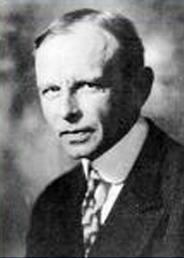
"Soil mechanics is the application of the laws of mechanics and hydraulics to engineering problems dealing with sediments and other unconsolidated accumulations of solid particles." "Few men in a lifetime have exerted an influence on their profession to compare with that of Karl Terzaghi on civil engineering and engineering geology " stated Arthur Casagrande in a memoir honoring his late mentor and friend. Until Terzaghi formally developed the field of soil mechanics, geotechnical engineering relied almost exclusively on experience and guesswork.
The colorful Austrian was born on October 2, 1883 in Prague where his father, Lieutenant-colonel Anton von Terzaghi, was stationed. Instead of following the military tradition of his forefathers, Terzaghi enrolled at the Technical University in Graz and graduated in 1904 with a "Diplom-Ingenieur " (M.Sc.) in mechanical engineering. Upon graduation Terzaghi worked for a Viennese engineering firm that specialized in dams and hydroelectric power plants. Practical experience on projects in Croatia and Russia, combined with a growing interest in geology, exposed Terzaghi to the gaps in knowledge between the geological conditions underlying construction projects and the engineering consequences resulting from these conditions.
After completing his doctorate degree in technical sciences in 1912 and a brief visit to the United States to explore the limited advances in earthwork engineering, Terzaghi returned to Europe as war broke out, serving two years as commanding officer of an aeronautical testing station near Vienna. In 1916 he was transferred to Constantinople to become a professor of foundation engineering at the Imperial Ottoman School of Engineering and later at Bogazici University. It was in Turkey that the young engineer first attempted to quantify the properties of the vast spectrum of soils by means of systematic experimentation. His findings were published in his seminal 1925 work Erdbaumechanik auf Bodenphysikalischer Grundlage (Earthwork Mechanics based on the Physics of Soils) which contained the fundamental differential equation for the consolidation process associated with clay compression, an equation analogous to the diffusion equation governing the time-dependent flow of heat in solids. The book also contains the theory of effective stress to explain the behavior of soils under loads. The success of the book led to positions at MIT and the Technical University of Vienna.
Although Terzaghi's ideas were met with skepticism in some civil engineering circles, he continued to write, lecture, and demonstrate the validity of his concepts by their practical application. As momentum within the new discipline grew during the 1930s, Terzaghi's disciple Arthur Casagrande organized the International Society of Soil Mechanics and Foundation Engineering. Terzaghi was elected the society's first President. Hitler's occupation of Austria brought Terzaghi and his family permanently to Harvard, where between 1938 and 1960 he would write two books and publish over 100 papers on topics ranging from the stability of slopes and conditions for the failure of soils to vibration problems and drainage mechanics. During the same period, Terzaghi's consulting work extended to earth dams, the stabilization of landslides, foundations for buildings, waterfronts, highways and airports. His second wife and geology PhD, Ruth Doggett, became a trusted associate and often accompanied Terzaghi on these consulting trips. Karl Terzaghi remains the only engineer to receive the Norman medal four times, the highest award of the American Society of Civil Engineers.

